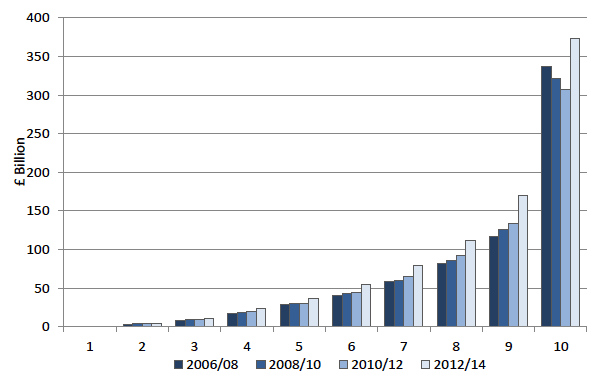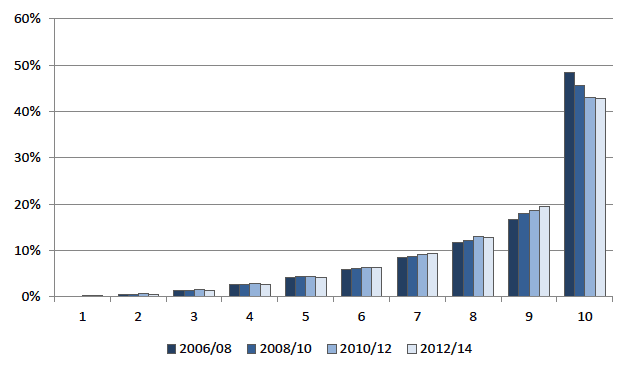Wealth and Assets in Scotland, 2006–2014
Analysis of the ownership of wealth by private households in Scotland from the Wealth and Assets 2006–2014 survey.
3 The Distribution of Wealth in Scotland
This chapter describes how the wealth of private households in Scotland is distributed.
This analysis is based on deciles, which divide the data into ten equal parts so that each part contains 10% of households - from the least wealthy households in the 1 st decile to the wealthiest in the 10 th decile. The median is also used to describe the distribution of wealth. The median represents the middle point at which half of households have less and half have more [1] . Findings are presented for total net household wealth, as well as for the four wealth components.
Some households have negative total net wealth, and the same applies to net financial wealth and net property wealth. This causes problems when, for example, calculating the proportion of wealth owned by households in a given decile. In these cases negative values have been set to zero for the analysis. This will underplay the real level of inequality for these wealth types [2] .
3.1 The distribution of total net wealth by decile
The distribution of household total net wealth was highly skewed towards the top. In 2012/14, the wealthiest 10% of private households in Scotland:
- Owned 43% of total net wealth which accounted for almost £374 billion;
- The value of wealth owned by the top 10% increased in 2012/14, following decreases in the previous waves;
- Were 4.9 times wealthier than the bottom 50% of Scottish households combined. The bottom 50% represented a 8.9% share of household total net wealth, worth £76.9 billion [3] .
Chart 3.1 shows that the value of total net wealth increased over the four survey periods. The share of total net wealth, by decile, is shown in chart 3.2. The value of household wealth has been increasing steadily for all but the wealthiest decile between 2006 and 2014. However, for the least wealthy 30% of households this increase is rather marginal.
The bottom 3 deciles own very little wealth: It is only when households move into the 4 th decile that they are able to accumulate wealth to any degree. In 2012-14, the bottom 30% of households owned 1.9% of total wealth.
The ownership of wealth remains very concentrated at the top of the distribution. In contrast to the low share of ownership of wealth by the bottom half of households, in 2012/14:
- The top 20% of households owned 62.8% of total net wealth.
- The top 10% of households owned 43.2% of total net wealth.
- The wealthiest 1% alone owned more wealth than the bottom 50%.
The value of household wealth starts to show increases over the survey periods from the 5 th decile onwards - that is, the value of wealth owned by the wealthiest half of households has increased over the survey periods, while increases in the value of wealth owned by the bottom half of households have been marginal. The wealthiest 10% of Scottish households saw decreases in the value of net total household wealth over the first three survey periods, from 2006 to 2012. In 2012/14, however, net total wealth for the top 10% of households increased substantially, mainly due to the increase in the value of private pension wealth.
In 2012/14, the median of household total net wealth for Scotland was £186,500 [4] . This means half of Scottish households had total net wealth of £186,500 or more, and half had total net wealth less than £186,500. For comparison, the median of household total net wealth for Great Britain was £225,000 [5] . The higher value of median wealth for Great Britain is largely due to the higher property values in England compared with Scotland.
Chart 3.1 Value of total net household wealth by decile 2006/08 - 2012/14

Source: Wealth and Assets Survey, ONS
Chart 3.2 Share of total net household wealth by decile 2006/08 - 2012/14

Source: Wealth and Assets Survey, ONS
Contact
Email: Andrew White
There is a problem
Thanks for your feedback